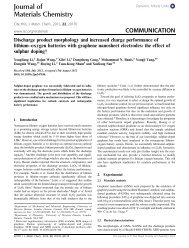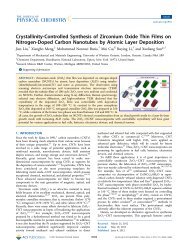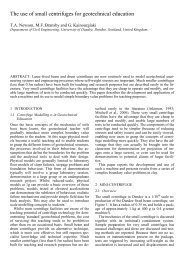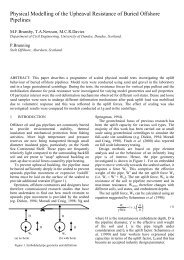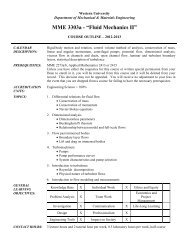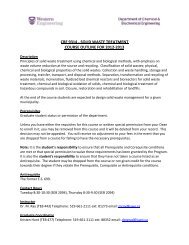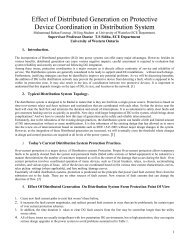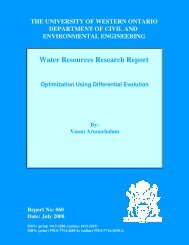Journal of Colloid and Interface Science - Western Engineering ...
Journal of Colloid and Interface Science - Western Engineering ...
Journal of Colloid and Interface Science - Western Engineering ...
You also want an ePaper? Increase the reach of your titles
YUMPU automatically turns print PDFs into web optimized ePapers that Google loves.
124 Y. Li et al. / <strong>Journal</strong> <strong>of</strong> <strong>Colloid</strong> <strong>and</strong> <strong>Interface</strong> <strong>Science</strong> 369 (2012) 123–128<br />
hydrochloric acid condition by MA-HM. 3D hierarchical nanostructures<br />
<strong>and</strong> 1D nanotubes <strong>of</strong> MnO 2 with different crystallographic<br />
forms were selectively obtained by controlling the reaction parameters.<br />
The growth mechanism was studied <strong>and</strong> discussed in detail<br />
based on detailed observations in different growth stages. This<br />
synthetic route requires no templates, catalysts, or organic<br />
reagents, which promises large-scale production <strong>of</strong> nanostructured<br />
MnO 2 with controlled structure <strong>and</strong> size.<br />
2. Experimental procedure<br />
All the chemicals used in this experiment were <strong>of</strong> analytical<br />
grade from Sigma–Aldrich Company <strong>and</strong> used without further<br />
purification. In a typical synthesis, 1.5 mmol <strong>of</strong> KMnO4 was added<br />
to 20 ml deionized water to form a homogeneous solution. 0.5 ml<br />
<strong>of</strong> HCl (37 wt.%) was then added dropwise into the solution under<br />
magnetic stirring. After stirring for 20 min, the obtained solution<br />
was transferred to a 100 ml Teflon-lined ceramic-walled vessel.<br />
The autoclave was sealed <strong>and</strong> heated to different reaction temperatures<br />
(100, 140, <strong>and</strong> 180 °C) with the same holding time <strong>of</strong> 25 min<br />
in an Anton Paar Synthos 3000 microwave synthesis system. After<br />
the autoclave was cooled down to room temperature, the sample<br />
was collected by centrifugation <strong>and</strong> washed with deionized water<br />
<strong>and</strong> absolute ethanol several times to remove the impurities, <strong>and</strong><br />
dried in air at 80 °C for 12 h.<br />
The powder X-ray diffraction (XRD) patterns were recorded by a<br />
Inel multipurpose diffractometer (MPD) system with CuKa radiation<br />
(k = 1.54060 Å) operated at 30 kV <strong>and</strong> 20 mA. The morphology<br />
<strong>of</strong> the synthesized samples was determined by a Hitachi S-4800<br />
field emission scanning electron microscope (FESEM) operated at<br />
5 kV. Transmission electron microscopy (TEM) images were taken<br />
by a Philips CM 10 microscope operated at 80 kV. High-resolution<br />
transmission electron microscopy (HRTEM) <strong>and</strong> selected area electron<br />
diffraction (SAED) were characterized by a JEOL 2010 FEG<br />
microscope operated at 200 kV. Fourier transform-infrared<br />
(FT-IR) measurements were carried out by the KBr method using<br />
a Nicolet 6700 FT-IR spectrometer. FT-IR spectra were recorded<br />
in the transmittance mode over the range <strong>of</strong> 400–4000 cm 1 by<br />
averaging 16 scans at a resolution <strong>of</strong> 4 cm 1 . Raman scattering<br />
(RS) spectra were collected on a HORIBA Scientific LabRAM HR Raman<br />
spectrometer system equipped with a 532 nm laser. A laser<br />
energy filter value <strong>of</strong> 2 was applied, which prevents decomposition<br />
<strong>of</strong> the samples. The spectra were taken between 100 <strong>and</strong><br />
1000 cm 1 in a backscattering configuration at room temperature.<br />
3. Results <strong>and</strong> discussion<br />
3.1. Structure <strong>and</strong> morphology characterization<br />
The phase purity <strong>and</strong> crystal structure <strong>of</strong> MnO2 were examined<br />
by XRD. Different crystal structures can be achieved by controlling<br />
the reaction temperatures. As shown in Fig. 1a, all the diffraction<br />
peaks <strong>of</strong> the XRD pattern for the sample prepared at 100 °C can<br />
be indexed to the birnessite-type MnO2 (JCPDS No. 80-1098),<br />
which has a lamellar structure <strong>and</strong> the interlayer distance <strong>of</strong><br />
MnO6 octahedra layers is 0.73 nm. The broaden peaks with low<br />
intensity observed in XRD pattern suggest that the sample is in<br />
poor crystalline state with a short-range crystal form. In particular,<br />
the relative intensities <strong>of</strong> the (001) planes are lower than those in<br />
the st<strong>and</strong>ard JCPDS data, which suggests that the layers <strong>of</strong> MnO6<br />
octahedra are not perfectly oriented [32]. In contrast, the sample<br />
prepared at 140 °C (Fig. 1b) can be attributed to the tetragonal<br />
phase a-MnO 2 (JCPDS No. 44-0141), <strong>and</strong> the XRD pattern with<br />
sharp <strong>and</strong> intense peaks indicates a good crystallinity for the a-<br />
MnO 2.<br />
Fig. 1. XRD patterns <strong>of</strong> the products prepared at (a) 100 °C <strong>and</strong> (b) 140 °C in 25 min.<br />
MnO2 with different crystal structures exhibited significantly<br />
different morphologies. Fig. 2 shows the SEM images <strong>of</strong> birnessite-type<br />
<strong>and</strong> a-MnO2. As shown in Fig. 2a, the birnessite-type<br />
MnO 2 sample is composed <strong>of</strong> uniform flower-like microsphere<br />
nanostructures with a diameter <strong>of</strong> 200–400 nm. The high-magnification<br />
images reveal that the microsphere consists <strong>of</strong> crumpled<br />
nanosheets about 10 nm in thickness (Fig. 2b). By comparison,<br />
the a-MnO 2 shows typical fibrous shape nanostructures with a<br />
length <strong>of</strong> 2–6 lm (Fig. 2c). The images at higher magnification<br />
(Fig. 2d) reveal that they have tubular structures <strong>and</strong> the diameter<br />
is about 100 nm.<br />
The interior structure <strong>of</strong> the flower-like microsphere nanostructures<br />
was further characterized by TEM <strong>and</strong> HRTEM. Fig. 3a shows<br />
core-corona architecture <strong>of</strong> the birnessite-type MnO2, which is<br />
similar to the previous report [33]. From the TEM image, it can<br />
be seen clearly that the nanosheets in the corona are grown perpendicularly/parallel<br />
from the core. The selected area electron diffraction<br />
(SAED) pattern (inset in Fig. 3a) <strong>of</strong> a typical microsphere<br />
indicates that it is polycrystalline. The HRTEM image (Fig. 3b) indicates<br />
that the corona is composed <strong>of</strong> thin sheets crystallized in the<br />
birnessite structure with a d-spacing about 0.6 nm. The distance is<br />
lower than the d-spacing between the (001) planes (0.73 nm),<br />
which is due to the dehydrating under the electron beam. It is noticed<br />
that the distance between nanosheets is not even <strong>and</strong> there<br />
are some dislocations along the nanosheet direction (red 1 dash circle<br />
in Fig. 3b), indicating the poor orientation <strong>of</strong> the (001) planes,<br />
which agrees with the XRD result.<br />
Fig. 3c <strong>and</strong> d show the TEM <strong>and</strong> HRTEM images <strong>of</strong> the a-MnO2<br />
nanotube structures. As shown in Fig. 3c, the a-MnO 2 nanotubes<br />
have relatively uniform outer diameters ranging between 80 <strong>and</strong><br />
100 nm, <strong>and</strong> the wall thickness is about 20 nm. The SAED pattern<br />
(inset in Fig. 3c) reveals the single-crystalline nature <strong>of</strong> the<br />
a-MnO 2 nanotubes. The lattice fringes in Fig. 3d show that the<br />
interplanar distance perpendicularly to the rod axis is 0.29 nm,<br />
which agrees with the d value <strong>of</strong> (001) planes <strong>of</strong> a-MnO 2. Therefore,<br />
the nanotubes grow along the [001] direction. The TEM <strong>and</strong><br />
HRTEM results are consistent with XRD data, confirming the<br />
mono-phase <strong>and</strong> good crystallinity <strong>of</strong> the a-MnO2 nanotubes.<br />
Fourier transform-infrared (FT-IR) <strong>and</strong> Raman scattering (RS)<br />
spectroscopy have been proved to be useful alternatives <strong>and</strong>/or<br />
supplements to X-ray diffraction for structural characterizations<br />
<strong>of</strong> materials [34]. Because they are sensitive to crystalline disorders<br />
as well as different local structural properties, FT-IR <strong>and</strong> RS<br />
1<br />
For interpretation <strong>of</strong> color in Figs. 1, 4–6, the reader is referred to the web version<br />
<strong>of</strong> this article.





